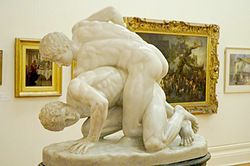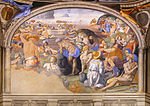Tribuna of the Uffizi
1580s establishments in ItalyBuildings and structures completed in 1584Individual roomsOctagonal buildings in ItalyUffizi

The Tribuna of the Uffizi is an octagonal room in the Uffizi gallery, Florence, Italy. Designed by Bernardo Buontalenti for Francesco I de' Medici in 1584, the most important antiquities and High Renaissance and Bolognese paintings from the Medici collection were and still are displayed here. The structure is octagonal because, according to Christian tradition, eight is the number which draws near Heaven. In 1737 the Grand Duchess Anna Maria Luisa de' Medici ceded the collection to the Tuscan government, and by the 1770s the Uffizi (and in particular the Tribuna) was the hub for Grand Tourists visiting Florence.
Excerpt from the Wikipedia article Tribuna of the Uffizi (License: CC BY-SA 3.0, Authors, Images).Tribuna of the Uffizi
Piazzale degli Uffizi, Florence Quartiere 1
Geographical coordinates (GPS) Address Phone number Website Nearby Places Show on map
Geographical coordinates (GPS)
| Latitude | Longitude |
|---|---|
| N 43.7681 ° | E 11.2557 ° |
Address
Galleria degli Uffizi
Piazzale degli Uffizi 6
50122 Florence, Quartiere 1
Tuscany, Italy
Open on Google Maps










